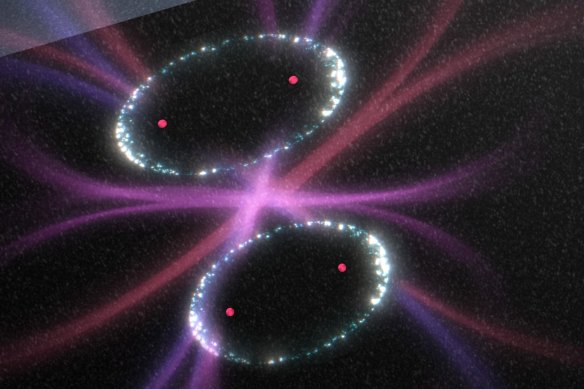- Analysis
- National
- Quantum Computing
This was published 11 months ago
Y2K was a flop. But Q-Day could really screw us over
By Angus Dalton
Examine, a free weekly newsletter covering science with a sceptical, evidence-based eye, is sent every Tuesday. You’re reading an excerpt – Sign up to get the whole newsletter in your inbox.
Y2K fashion is back, baby! But amid the resurgence of low-rise jeans, Nickelback and service station sunglasses, the defining trend of the era has been strangely neglected: crippling societal fear of a digital Armageddon.
I’m here to rectify that. There’s a new Millennium bug heading our way, and this time, it’s quantum-powered.

Y2K was all bang, no bite. Could Q-Day deliver on the promise of chaos?Credit: Rob Homer
It’s called Q-Day, and it refers to the moment when quantum computing becomes powerful enough to crack the encryption systems that underpin our digital society.
Banking could be disrupted and accounts pilfered. Private messages, health records, government secrets hacked and exposed in seconds. Military plans, weapon design and classified intelligence from ASIO left ripe for the picking by anyone with access to the right quantum tools.
“When there’s a reasonably sized quantum computer that will be able to break a standard encryption mechanism, that will be Q-Day,” Dr Fida Hasan, a UNSW lecturer in cybersecurity, says.
Unlike Y2K, we don’t have a time and date for when Q-Day will strike. Some predict it will come within 10 to 15 years, Hasan says. Others reckon it will arrive much quicker as governments pour funds into the quantum computing race, just as we saw on Tuesday with a $1 billion quantum boost for Australia, courtesy of the federal and Queensland governments.
Hasan recently published a paper urging the rollout of quantum-proof encryption systems to defend against increasingly sophisticated future attacks. If we’re not ready for Q-Day, he and other experts warn, the results could be devastating.
How quantum changes everything
The government just turbocharged Australia’s already world-leading quantum potential with a $1 billion boost into US-based company PsiQuantum, which will base its headquarters in Brisbane.
The goal is to spur the creation of the world’s first commercial-scale quantum computer, which would be “the most complex machine ever built by humanity,” Australia’s chief scientist Dr Cathy Foley told the ABC.
Quantum computing harnesses the physics of subatomic particles – such as electrons and photons – to store data and perform calculations.

Minister for Industry and Science Ed Husic at the quantum labs at Sydney University.Credit: Dion Georgopoulos
The units that make up a normal computer’s power, called “bits”, execute their operations by flipping between the binary states of zero or one. The units of a quantum computer, called “qubits”, can exist between these binary states. That radically boosts computing power.
Quantum computing could help us identify and design new life-saving medicines, and will have other applications we can’t even imagine yet.
But current quantum computers are limited by size; the largest is made of 1121 qubits. They also have to be kept at temperatures close to absolute zero to work properly. And because qubits are so fragile, the computers are prone to error. A tiny disturbance can wipe data or ruin a calculation. That’s why we hear so much about the quest for an “error-corrected” quantum system.
But quantum tech is getting plenty of funding and it’s developing at a pace described as “doubly exponential”.
Once developers achieve error-corrected, large-scale quantum computing, quantum-powered hacking will become a reality.
And the chaos is already afoot. Bad actors have started hoarding data they plan to crack open once quantum hacking becomes possible, Hasan says, with a tactic dubbed “harvest now, decrypt later”.
So how do we survive Q-Day?
Encryption protects data with complex mathematical problems, says Monash University cryptography researcher Dr Muhammed Esgin.
The mathematics behind one form of encryption, called RSA, involves calculating two numbers multiplied together to produce a massive third number. The numbers in these problems are so large it would take even a supercomputer billions of years to solve.
But it turns out quantum computers are very good at this type of calculation. It might take a quantum computer days – or less – to crack. That’s why Esgin is helping hunt for new cryptography algorithms protected by mathematical problems that make even quantum computers sweat.

Classic computers perform calculations using ones and zeros. Quantum computers use qubits, which are in a quantum state of both one and zero at the same time.Credit: Tony Melov / UNSW
These algorithms include mathematical problems based on “lattices” – grids of repeating patterns – that are infinitely harder to solve than RSA.
The National Institute of Standards and Technology (NIST) in the US leads the world’s cybersecurity community in determining the use of new encryption algorithms. In 2022, it unveiled four new algorithms designed to withstand quantum attack. Three of the four were based on lattices.
But a recent paper threw the mathematic and cybersecurity world into a panic. A cryptographer called Yilei Chen claimed he had found a way in which quantum computers could solve lattice problems and potentially bust these new algorithms.
Thankfully, other researchers quickly identified a bug in his algorithm, which led to a retraction of his work. The lattices held strong, and Q-Day preppers breathed a sigh of relief. Mathematicians will continue to try to crack these algorithms to make sure they’re as resistant to quantum attack as we hope.
Microsoft and Google have already started building these new algorithms into their cybersecurity systems, but the process can take years, and it’s one we’ve barely started.
Our government predicts “cryptographically relevant” quantum technology – i.e. Q-Day – is more than two decades away. But not preparing in time would be devastating.
“That would be quite catastrophic,” Esgin says. “When we do our banking online, use WhatsApp, when you buy something on Amazon … all of these things use cryptography. Our world is digitised. I don’t think there is any way we cannot be prepared for Q-Day.”
Examine, a free weekly newsletter covering science with a sceptical, evidence-based eye, is sent every Tuesday. You’re reading an excerpt – sign up to get the whole newsletter in your inbox.